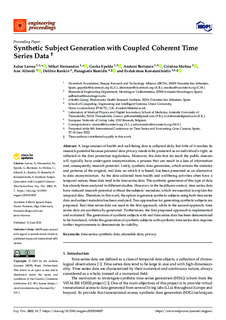Izenburua
Synthetic Subject Generation with Coupled Coherent Time Series Data †Egilea (beste erakunde batekoa)
Argitalpen data
2022Beste erakundeak
VicomtechInstituto de Investigación Sanitaria Biogipuzkoa
University of Ulster
Aristotle University of Thessaloniki
European Network of Living Labs (ENoLL)
Bertsioa
Bertsio argitaratuaDokumentu-mota
ArtikuluaArtikuluaHizkuntza
IngelesaEskubideak
© 2022 The AuthorsSarbidea
Sarbide irekiaArgitaratzailearen bertsioa
https://doi.org/10.3390/engproc2022018007Non argitaratua
Engineering Proceedings Vol. 18. N. 1Argitaratzailea
MDPIGako-hitzak
time seriessynthetic data
shareable data
Privacy
Laburpena
A large amount of health and well-being data is collected daily, but little of it reaches its research potential because personal data privacy needs to be protected as an individual’s right, as reflec ... [+]
A large amount of health and well-being data is collected daily, but little of it reaches its research potential because personal data privacy needs to be protected as an individual’s right, as reflected in the data protection regulations. Moreover, the data that do reach the public domain will typically have under-gone anonymization, a process that can result in a loss of information and, consequently, research potential. Lately, synthetic data generation, which mimics the statistics and patterns of the original, real data on which it is based, has been presented as an alternative to data anonymization. As the data collected from health and well-being activities often have a temporal nature, these data tend to be time series data. The synthetic generation of this type of data has already been analyzed in different studies. However, in the healthcare context, time series data have reduced research potential without the subjects’ metadata, which are essential to explain the temporal data. Therefore, in this work, the option to generate synthetic subjects using both time series data and subject metadata has been analyzed. Two approaches for generating synthetic subjects are proposed. Real time series data are used in the first approach, while in the second approach, time series data are synthetically generated. Furthermore, the first proposed approach is implemented and evaluated. The generation of synthetic subjects with real time series data has been demonstrated to be functional, whilst the generation of synthetic subjects with synthetic time series data requires further improvements to demonstrate its viability. [-]
Bildumak
Item honek honako baimen-fitxategi hauek dauzka asoziatuta:






















